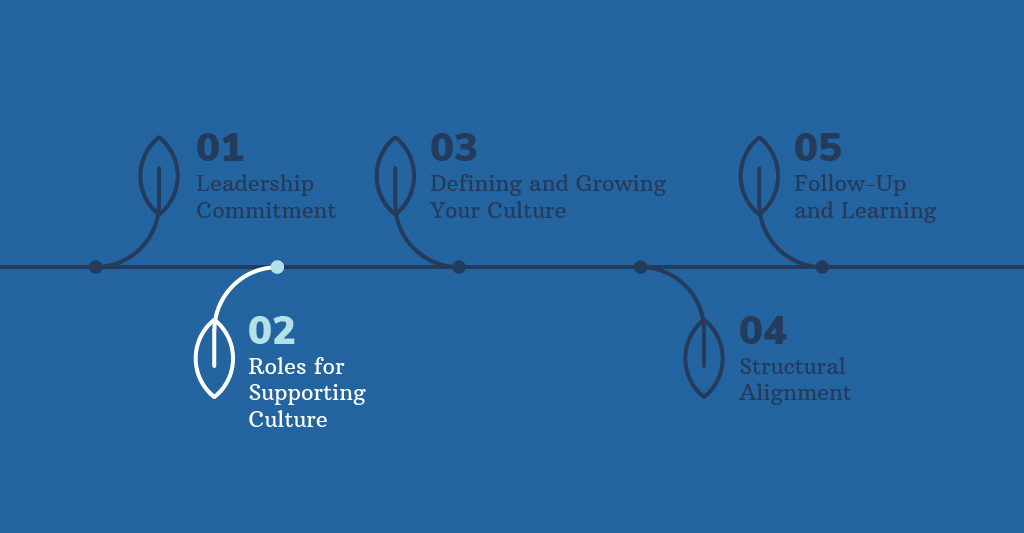Last week, we began our journey through the components necessary for growing your desired culture and focused on Leadership Commitment. Today, we continue with Roles for Supporting Culture.

Roles for Supporting Culture
Just as you have leaders responsible for HR, finance, and communication, you also need a leader to address the cultural journey and ensure that it is taking place. Someone must be assigned to the role of Culture Manager—it’s not going to take care of itself. Established departments are often at capacity with other strategic objectives and may have difficulty taking on another dimensional responsibility. It is also important that this role work across all departments and divisions to develop and care for the ongoing transformation of the culture.
Candidates for this role need particular experience and training to execute the culture initiatives effectively. In addition to the Culture Manager, other employees throughout the organization should be trained to support the culture initiatives. This, in a way, is transforming your leadership culture—the way your leaders behave and what they place value on—to emphasize the importance of the organizational culture.
CULTURE MANAGER
The primary role of the Culture Manager is to be the “guardian” of the culture. Neither the designer of the culture nor its primary promoter, this person keeps track of what is happening in the culture. The Culture Manager also develops organization-wide programs and specific interventions that enable the culture to develop in line with the changing needs of the organization, employees, and external stakeholders.
This role must be internal, with a clear and direct connection to the CEO and top management.
CULTURE AMBASSADOR
Culture doesn’t just happen at the top. Transformation must occur throughout the organization. Culture Ambassadors are managers and employees who are trained to promote culture initiatives. They represent the organizational culture, provide valuable perspective about whether the culture is being lived among their teams, and facilitate frequent dialogue with employees about the values and behaviors that are necessary to support shifts in the organization’s strategy. Having one cultural ambassador for approximately every 50–75 employees should provide a critical mass of people for cultural transformation.
![]()
 In 2017, Ashley Munday, Former Director of Thrive by SweetRush, and Tor Eneroth, Director of Cultural Transformation at Barrett Values Centre, wrote an eBook as a resource and workbook for leaders to get started on the culture journey in a meaningful and tactical way. To accommodate as many leaders as possible, we have converted the content into a series of articles that can be read piece by piece and will be publishing them on a weekly basis. We invite you to consume the material at your own pace and welcome your feedback and questions along the way. Thrive by SweetRush is now known as Transforming Leaders and Culture (TLC) by SweetRush. Please reach out to begin transforming your organization today!
In 2017, Ashley Munday, Former Director of Thrive by SweetRush, and Tor Eneroth, Director of Cultural Transformation at Barrett Values Centre, wrote an eBook as a resource and workbook for leaders to get started on the culture journey in a meaningful and tactical way. To accommodate as many leaders as possible, we have converted the content into a series of articles that can be read piece by piece and will be publishing them on a weekly basis. We invite you to consume the material at your own pace and welcome your feedback and questions along the way. Thrive by SweetRush is now known as Transforming Leaders and Culture (TLC) by SweetRush. Please reach out to begin transforming your organization today!
![]()
If you’re reading this series, we know you are a leader who understands and cares about the way your organization’s culture supports its people and its purpose—for that, we thank you! Check out the other articles in this series:
- Culture Change in Organizations Begins Within
- Organizational Culture Transformation—A Journey, Not a Destination
- Culture Change Case Study: Volvo IT
- Changing Corporate Culture Case Study: Old Mutual Group
- Cultural Change In Organizations Example: Unilever Brazil
- Key Learnings in Culture Transformation
- Growing Your Desired Culture: Leadership Commitment
- Growing Your Desired Culture: Roles for Supporting Culture
- Growing Your Desired Culture: Defining and Growing Your Culture
- Growing Your Desired Culture: Structural Alignment
- Growing Your Desired Culture: Follow-Up and Learning




